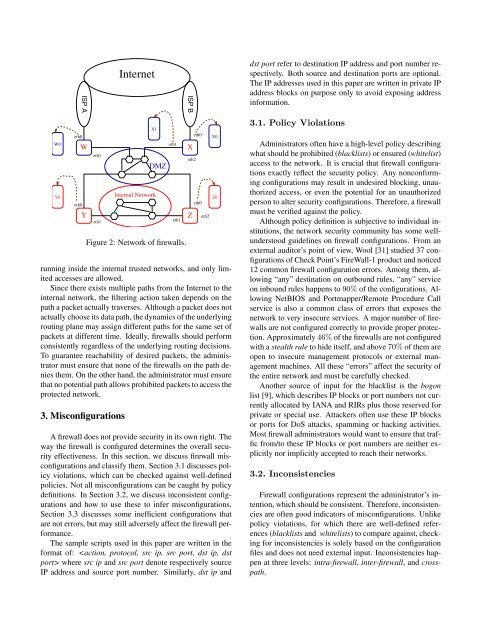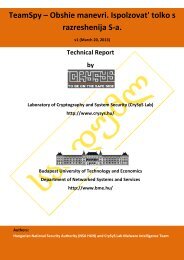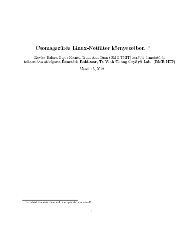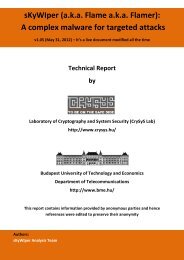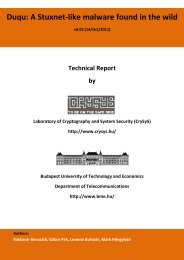FIREMAN: A Toolkit for FIREwall Modeling and ANalysis
FIREMAN: A Toolkit for FIREwall Modeling and ANalysis
FIREMAN: A Toolkit for FIREwall Modeling and ANalysis
Create successful ePaper yourself
Turn your PDF publications into a flip-book with our unique Google optimized e-Paper software.
W0<br />
Y0<br />
eth0<br />
eth0<br />
ISP A<br />
W<br />
Y<br />
eth1<br />
eth1<br />
Internet<br />
X1<br />
Internal Network<br />
DMZ<br />
eth1<br />
eth1<br />
Figure 2: Network of firewalls.<br />
running inside the internal trusted networks, <strong>and</strong> only limited<br />
accesses are allowed.<br />
Since there exists multiple paths from the Internet to the<br />
internal network, the filtering action taken depends on the<br />
path a packet actually traverses. Although a packet does not<br />
actually choose its data path, the dynamics of the underlying<br />
routing plane may assign different paths <strong>for</strong> the same set of<br />
packets at different time. Ideally, firewalls should per<strong>for</strong>m<br />
consistently regardless of the underlying routing decisions.<br />
To guarantee reachability of desired packets, the administrator<br />
must ensure that none of the firewalls on the path denies<br />
them. On the other h<strong>and</strong>, the administrator must ensure<br />
that no potential path allows prohibited packets to access the<br />
protected network.<br />
3. Misconfigurations<br />
A firewall does not provide security in its own right. The<br />
way the firewall is configured determines the overall security<br />
effectiveness. In this section, we discuss firewall misconfigurations<br />
<strong>and</strong> classify them. Section 3.1 discusses policy<br />
violations, which can be checked against well-defined<br />
policies. Not all misconfigurations can be caught by policy<br />
definitions. In Section 3.2, we discuss inconsistent configurations<br />
<strong>and</strong> how to use these to infer misconfigurations.<br />
Section 3.3 discusses some inefficient configurations that<br />
are not errors, but may still adversely affect the firewall per<strong>for</strong>mance.<br />
The sample scripts used in this paper are written in the<br />
<strong>for</strong>mat of: where src ip <strong>and</strong> src port denote respectively source<br />
IP address <strong>and</strong> source port number. Similarly, dst ip <strong>and</strong><br />
ISP B<br />
X<br />
eth2<br />
Z<br />
eth0<br />
eth0<br />
eth2<br />
X0<br />
Z0<br />
dst port refer to destination IP address <strong>and</strong> port number respectively.<br />
Both source <strong>and</strong> destination ports are optional.<br />
The IP addresses used in this paper are written in private IP<br />
address blocks on purpose only to avoid exposing address<br />
in<strong>for</strong>mation.<br />
3.1. Policy Violations<br />
Administrators often have a high-level policy describing<br />
what should be prohibited (blacklists) or ensured (whitelist)<br />
access to the network. It is crucial that firewall configurations<br />
exactly reflect the security policy. Any noncon<strong>for</strong>ming<br />
configurations may result in undesired blocking, unauthorized<br />
access, or even the potential <strong>for</strong> an unauthorized<br />
person to alter security configurations. There<strong>for</strong>e, a firewall<br />
must be verified against the policy.<br />
Although policy definition is subjective to individual institutions,<br />
the network security community has some wellunderstood<br />
guidelines on firewall configurations. From an<br />
external auditor’s point of view, Wool [31] studied 37 configurations<br />
of Check Point’s FireWall-1 product <strong>and</strong> noticed<br />
12 common firewall configuration errors. Among them, allowing<br />
“any” destination on outbound rules, “any” service<br />
on inbound rules happens to 90% of the configurations. Allowing<br />
NetBIOS <strong>and</strong> Portmapper/Remote Procedure Call<br />
service is also a common class of errors that exposes the<br />
network to very insecure services. A major number of firewalls<br />
are not configured correctly to provide proper protection.<br />
Approximately 46% of the firewalls are not configured<br />
with a stealth rule to hide itself, <strong>and</strong> above 70% of them are<br />
open to insecure management protocols or external management<br />
machines. All these “errors” affect the security of<br />
the entire network <strong>and</strong> must be carefully checked.<br />
Another source of input <strong>for</strong> the blacklist is the bogon<br />
list [9], which describes IP blocks or port numbers not currently<br />
allocated by IANA <strong>and</strong> RIRs plus those reserved <strong>for</strong><br />
private or special use. Attackers often use these IP blocks<br />
or ports <strong>for</strong> DoS attacks, spamming or hacking activities.<br />
Most firewall administrators would want to ensure that traffic<br />
from/to these IP blocks or port numbers are neither explicitly<br />
nor implicitly accepted to reach their networks.<br />
3.2. Inconsistencies<br />
Firewall configurations represent the administrator’s intention,<br />
which should be consistent. There<strong>for</strong>e, inconsistencies<br />
are often good indicators of misconfigurations. Unlike<br />
policy violations, <strong>for</strong> which there are well-defined references<br />
(blacklists <strong>and</strong> whitelists) to compare against, checking<br />
<strong>for</strong> inconsistencies is solely based on the configuration<br />
files <strong>and</strong> does not need external input. Inconsistencies happen<br />
at three levels: intra-firewall, inter-firewall, <strong>and</strong> crosspath.


